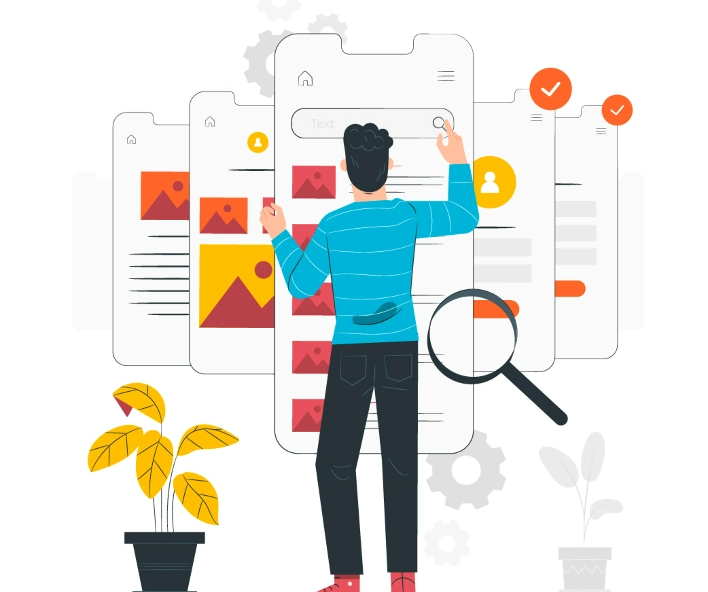
Published
Read
Tag
Content Headings
Share
A Pathway That Our UX/UI Designers Follow Before Designing Your App
UX designers are entering the market and making significant progress. UX designers focus on improving the features of apps to provide the most optimal user experience. Over the past few years, UX/UI designers have worked out of their way to bring creativity to their apps. However, they made a blunder in the end.
It is common for designers to become so enamoured with highly designed creative apps that they fail to remember the needs of the target audience. Nevertheless, various UX designers can understand the needs and demands of clients and can deliver applications that follow the latest trends. However, there is still much work to be done on the designs of different apps.
Once in a while, you may have encountered an app that opened with large fonts, bright colours, and various things happening in the background. You may have uninstalled it within a few seconds. UX/UI designers face this problem of user retention today. Furthermore, in this article, we will discuss the pathway that could help UX/UI designers to design effective apps.

User research
Discovering the target audience and identifying the needs of the users is the first step a UX/UI designer should take while developing a mobile app. User research enables the business to gain insights as to what types of clients are there and also get to know about their changing needs and desires.
Research should be carried out properly and efforts should be made to reach out to users at a detailed level. Several organizations have different steps involved in the user research process like identifying the competitive app and their users, connecting with users of different demands, testing the concepts, etc.
Outline of the app
After the user research process, the UX designers should draw the app and the features that they want to incorporate into it. Here, all the requirements of the users should be listed down in line with the features of the app. It is critical to create a rough sketch of the app at the beginning of the development process, so that the designers know where to focus next. Making a rough sketch of the app would also be helpful in planning and strategizing its various features. Furthermore, the designers can also make use of the design templates and tools available to them to create an app that meets the needs of users.

Building user persona
Developing user personas is one of the most significant aspects that the app designers must take into account. App designers can group or segment users based on different factors by using user personas. Generally, segmentation is carried out based on 2 significant segments which are demographic and psychographic.
Demographic information is composed of the user’s personal information like age, gender, education, culture, income group, etc. In contrast, the psychographic group includes information regarding the behaviours, attitudes, likes, and dislikes of the users.
Wireframes
The next crucial step is developing the information architecture and the wireframes of the app. The wireframe is the outline of the app that displays all the elements on the screen in a specific order. It also determines whether it fits the overall design of the website or not. Developing the information architecture or wireframes involves several steps, such as arranging content, defining information relationships, and making sure that users can navigate with ease.
Design the visual aspects of the app
Next, it is important to evaluate the visual identity and design of the application. Many people confuse the visual design of the app with the way it appears and feels. In reality, that's not the case. Furthermore, the visual design incorporates the usability and functionality of the application. The kind of user experience an app can provide to its users is considered. While designers are mostly concerned with the look and feel of the app, other crucial aspects such as usability and functionality should also take into consideration when developing this aspect.
Prototype
The prototype is the stage in the designing process where the app development company develops interactive sketches that look and work like the final product. Prototype design can help a lot and plays a pivotal role in the success of an app. For several reasons, prototyping is an essential part of the app development process. Two of the major reason is listed below.
Visualization: Till now, the app has only been visualized and the features have been designed. The prototype of the app allows the stakeholders, users, and other people involved to see what the actual app would look like.
Feedback: Users and stakeholders who view the app prototype can provide feedback and comment on both its positive and negative aspects.
On receiving the negative feedbacks, an app development company could analyse the loopholes further and resolve them. Then they could release the final product to be used by the people. In this way the users can save both time and money and can receive exactly what they need.

Testing of the app
This is the final stage in the app development process. In this case, the app is reviewed and certified to meet the needs and demands of its users. When usability testing is completed, it can be seen how the real users use the app. Also, an expert team has been set up to inspect the app's testing process. To provide the most excellent user experience possible, the team looks for issues and offers solutions to them.
Conclusion
Designing an app is not an easy task. It takes many months and years to develop an app that will be able to meet all the needs and requirements of its users. It is therefore critical to keep certain factors in mind when designing. Various factors play a pivotal role in the app development process. Teamwork and coordination are one of the important aspects. At each stage, the app should be tested and the app should be designed in such a way that it meets the expectations of the users.
